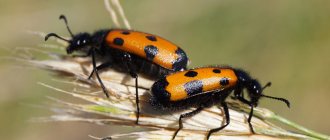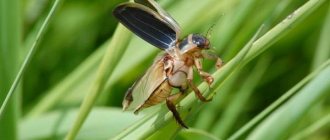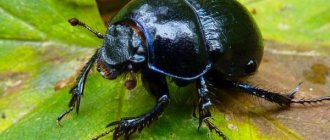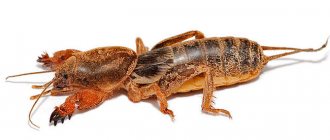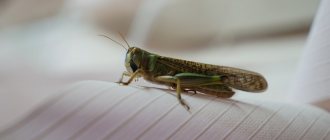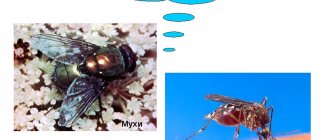Many members of the ground beetle family are entomophagous. Predatory beetles feed on pests of fields, gardens and forests. The odorous beetle is a typical representative of the family, helping to get rid of caterpillars in mixed forests and parks. The large beetle attracts with the bright, iridescent color of its elytra. The tireless hunter lives in the upper tier of the plantings. He flies well and is active during the daytime. Over the summer, adults and larvae kill hundreds of pests. The beneficial insect is in danger of extinction. The odorous krasotel is listed in the Red Book of Russia.
Description of the beauty beetle
This is one of the most beautiful representatives of the Coleoptera order. Bright wide and ribbed elytra shimmer, acquiring a blue, green or golden color with a reddish tint.
The head and pronotum are usually dark blue. The size of this beetle varies from 20 to 30 mm. Occasionally larger individuals are also found. This beetle belongs to the category of predators, as evidenced by its powerful jaws, adapted for hunting fairly large butterfly caterpillars.
Describing what the beauty beetle looks like, one cannot help but note its amazing ability to secrete a secretion that has a very pungent odor in case of danger. Thanks to this feature, the beetle received the name “odorous”.
Appearance
The body length of the insect is 35 mm. The beetle's body is elongated and its head is small. The beauty's eyes are large. The filamentous antennae are divided into 11 segments. The pronotum of the insect is dark blue. The greenish elytra with a golden tint have many parallel depressions. The ground beetle's abdomen is black, as are its legs. The limbs of the insect are well adapted for running. The beauty has quite powerful mandibles, which helps to hold the prey.
Beauty beetle - interesting facts
The main difference between this insect and ordinary large ground beetles is its ability to move deftly through trees, eating caterpillars. In addition, the beetle flies excellently and can cover considerable distances in search of food. After the main food gradually disappears towards the end of summer, insects begin preparing for winter, which they spend in the soil, under a layer of foliage.
With the onset of spring, the beetles begin the mating period and egg laying. One female can lay about 100 eggs, of which the larvae hatch after about 5–7 days. Mating can occur several times in one season. Juveniles appear in August or early September. An adult beetle beetle can live up to 4 years.
Although it is a predator, the insect is nevertheless endowed with a weapon of defense. When danger appears, the beetle turns to the enemy with the back of its body, throwing a stream of poisonous and very odorous liquid in his direction. It does not pose a serious danger to humans, but can cause itching and irritation of the skin or mucous membranes.
Lifestyle and reproduction
The odorous krasotel benefits people. An entomophagous predator helps control the number of dangerous tree pests:
- leaf roller;
- Volyanka;
- ringed and gypsy moths.
Beetles attack larvae and butterflies.
The beauty runs and flies quickly. It hunts in the upper tier and descends to the ground to eat prey. Peak activity of adults occurs in the afternoon and evening. Larvae hunt at any time. Young beauties do not eat their prey entirely, but inflict fatal wounds on it. Adult beetles find caterpillars and moths by moving along tree trunks and branches. Having caught an insect, they try to find a convenient area for eating. The hunter does not always have enough strength to pull down a large hairy caterpillar; in this case, he feeds on a wide branch. Krasotel treats the victim's body with special softening enzymes. The beetle larvae have adapted to destroy the silkworm's web nests. Over the summer, they rid the forest of 60 caterpillars and 20 pupae. Adult beetles are more efficient; they have about 300 caterpillars.
Information. As a defense mechanism, krasotel uses secretions from glands located on the abdomen. The strong and pungent odor deters predators. This feature is reflected in the name “Odoriferous Krasotel”.
Reproduction
Mating occurs in the spring. The female lays from 100 to 600 eggs in the soil. The ability to reproduce depends on the amount of food. Females need large amounts of protein. As the population of pest caterpillars increases, the number of beetles also increases. 1-2 weeks after laying, small larvae appear. They do not immediately leave the egg cradle, but wait for the appearance of a hard black cover. The offspring actively feeds and grows, molting and changing ages. In mid-July they burrow 25 cm into the soil and pupate. By August, young adults appear. The beetles do not leave the cocoons, remaining in them for the winter.
One generation of beauty beetles changes per year. The lifespan of insects is 2-4 years. Adult beetles hide in the forest floor for the winter. The following year they appear along with the young in May-June.
Feeding of the beauty beetle
The favorite food for this insect are caterpillars, which mostly live in the crowns of trees. The beauty beetle seeks out its prey by sight, and not by smell, unlike other ground beetles. He chases her, deftly running along a tree trunk, and then, grabbing her, drags her to the ground, where he kills her and begins to eat. First, the beetle, having filled the caterpillar’s body with its saliva, turns it into a liquid pulp for more convenient absorption. Its powerful jaws, which are clearly visible in the photo of the beauty beetle posted in this article, also help it in this.
Caterpillars and pupae of a wide variety of butterflies are eaten as food, including such serious forest pests as the nun moth, gypsy moth, and corydalis. This predator can also handle very hairy caterpillars, which even insectivorous birds do not eat. It is not for nothing that he is called a comrade of foresters and the winner of the silkworm. In one season, the beauty beetle and its family are capable of destroying up to 6 thousand caterpillars. He also hunts butterflies dozing on the branches of trees, killing them and biting into their abdomen.
In addition, the predator does not disdain completely different food. It happens that the beetle also attacks unfledged chicks sitting in the nest. Its victim may also be any other beetle that gets in the way, even if it is much larger in size.
Where does it live?
Currently, the insect is found in the USA and Canada, in Asia Minor and Central Asia. The ground beetle lives in Portugal and the Southern Urals, in the south of England and Sweden, and in Kazakhstan. In the Russian Federation, fragrant beetle is found in Kaliningrad and the Sverdlovsk region. The species was recently introduced to North America. The odorous beetle prefers deciduous forests; sometimes this insect can be found in a coniferous forest, in a park or in a garden.
Nutrition of larvae
Until the covers of the newborn larva become black and shiny, it remains in its egg cradle. Then she crawls to the surface of the soil and begins to search for food. The larva is no less aggressive a predator than the adult beauty beetle, a description of the methods of obtaining food for which is given above.
On the head of the larva there are the same powerful jaws, each of which is equipped with a sharp tooth on the inside. Thanks to them, it is easy to restrain a captured victim by sucking out its contents. Typically the larva eats only a small portion of its prey. They hunt almost around the clock. In search of food, the larvae deftly crawl into the web nests of silkworms, whose caterpillars live in large clusters. By emptying them, they thereby bring great benefit by curbing the growth of the number of these harmful insects.
What does it eat?
This representative of ground beetles is a rather aggressive predator, an entomophage. It feeds on the larvae of butterflies and nun moths, eating them along with their hairs. An adult butterfly can also become its prey. Having caught the victim, the insect immediately begins to look for a place for lunch. When he cannot drag the butterfly down, the beauty eats it directly on the branch. The beetle secretes enzymes that soften the body of the prey and holds it with its tenacious paws. The beetle larvae can feed on ringed silkworm pupae; during the summer, beetles at this stage are capable of eating about 20 such insects.
Benefits of the beauty beetle
This type of insect was used in France as early as 1840 for the purpose of biological control of caterpillars of pest butterflies. To destroy the gypsy moth, it was later brought to America, where it was bred in special insectariums. The beauty beetle is a predator no less useful than the well-known ladybug, which destroys aphids. The large size of the beetle allows it to cope with pests of the appropriate “size”. Living in large numbers in gardens and fields, these predators help people, relieving them of the need to spend effort and money fighting insect pests.
Interesting facts about insects
The fragrant krasotel attracts not only its beautiful coloring and large dimensions. In the descriptions of this insect, the unusual facts characteristic of it are of interest:
- When an uncontrollable situation with the massive development of the gypsy moth occurred in America, beauties were brought in to combat the pest and successfully acclimatized to the new conditions.
- The larvae of the beautiful iridescent beetles are almost twice as long as the adult.
- It is not recommended to handle the beauty ones, as they bite painfully. Swelling may develop in the affected areas and an allergic rash may appear.
- The aromorphosis in the form of movable limbs, characteristic of arthropods, allows all types of ground beetles to hunt effectively.
- In case of danger, the predatory insect secretes a sharp-smelling secretion. This is the reason for the epithet “odorous”.
The large beetle easily lifts significant weight, usually dragging its prey to the surface of the ground. If this fails, he arranges a feast directly on the tree.
The gradual disappearance of beauty beetles is of serious concern, especially among conservation and forestry workers. These predatory insects help save trees from many pests, so it is necessary to develop a set of measures not only to protect them, but also to reproduce the population.
Do you have any questions about the Beetle Krasotel or something to add? Then write to us about it in the comments, this will make the material more useful, complete and accurate.
Limiting factors
The number of the beauty beetle has been declining sharply recently. In some regions it is practically no longer found, and can only be seen in photographs. The beauty beetle was included in the Red Book of Russia, Belarus, Ukraine, and Tatarstan. It is also protected in all Western European countries.
One of the reasons for the extinction of this species is the massive treatment of forests and forest belts with pesticides, carried out to combat gypsy moth caterpillars. The beauty beetle is very sensitive to these poisons, which gradually accumulate in its body and lead to death. In order to preserve its population, it is necessary to prohibit chemical treatment in protected areas.
Useful or harmful
The fragrant beetle is a beneficial insect. This is expressed in the fact that no one except him can cope with silkworms and poisonous caterpillars. It inhibits their uncontrolled growth and reproduction. Adult beetles destroy the caterpillars themselves, and its larvae have adapted to destroy silkworm nests from cobwebs.
FROM this video you can learn some interesting facts about these beetles:
In nature, there is no other natural biological “controller” for the growth of the population of harmful caterpillars.





